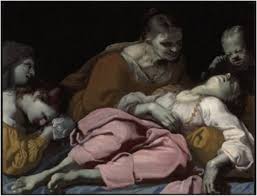The Birth of Benjamin and the Death of Rachel
35: 16-20
No sooner had Ya’akov finished burying Deborah, Rebekah’s nurse (35:8), than he had to bury Rachel. Then, after fulfilling Jacob’s vow, they moved on from Bethel, and while they were on the road to Bethlehem, his beloved Rachel died in childbirth (35:16a). The family was now complete with the birth of Benjamin. Interestingly enough, eleven of Jacob’s twelve sons were born outside the Promised Land in Paddan Aram.
According to First Samuel 10:2 she died on the border of Benjamin and Zelzah. And we know from First Samuel 7:17 that Samuel lived up in Ramah, a Benjaminite city. Therefore, Rachel’s burial place was in the city of Ramah, which is north of Jerusalem (Jeremiah 31:15). The site that tour guides point to as Rachel’stomb on the outskirts of Bethlehem, which is south of Jerusalem, is not the actual location of Rachel’s tomb. The rabbis follow tradition and teach that Rachel’s tomb is south of Yerushalayim in Beit-Lechem.

In Ramah, on the road to Bethlehem, Rachel began to give birth and had great difficulty (35:16b). Rachel must have been over one hundred years old by this time. And as she was having great difficulty in childbirth, at the point of greatest pain, the midwife tried to encourage her by saying: Don’t be afraid, for you have another son. Fifteen years earlier, she had prayed for another son when Joseph was born. Finally, she became pregnant again, but it cost Rachel her life. As she breathed her last, for she was dying, she named her son Ben-Oni, which means the son of my sorrow (the word for sorrow and birth pangs are synonymous), because he is causing her death. But his father renamed him Benjamin, which means the son of my right hand or son of my strength (35:17-18). From the start of his life Benjamin had two things that set him apart from his brothers. First, he was the only son born in the Promised Land, and secondly, he was the only son named by his father.
Jacob’s love for Rachel was timeless. Many years afterwards, her death was still fresh in his mind. On his deathbed, when he was preparing to bless his sons, he remembered that he had buried her with great sorrow (48:7). So Rachel died and was buried in Ramah, north of Jerusalem (35:19). Over her tomb Ya’akov set up a pillar, and Moses comments that the pillar that marked Rachel’s tomb was visible even until his time (35:20). To this Samuel referred when he sent Sha’ul home after anointing him (First Samuel 10:2). It might have been visible during Jeremiah’s day as the Jews were being taken into the Babylonian captivity. But it is no longer visible today, which is why the location of the tomb has been lost and misplaced in Beit-Lechem.
The birth of Benjamin also points forward to the Yosef narrative (Chapters 37-50), and ultimately to the fuller story of the nation of Isra’el. As such, Chapter 35 serves as a transition from the patriarchal period of Abraham, Isaac and Jacob, to the beginnings of the people of Isra’el.539



Leave A Comment